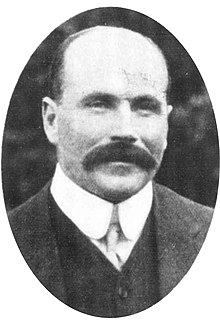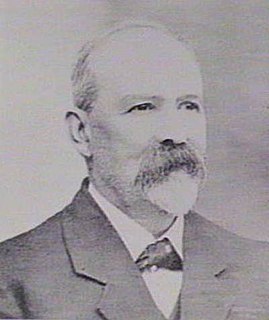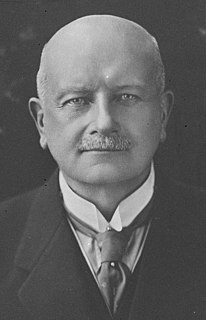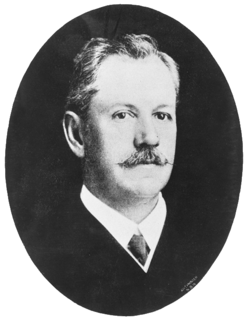The Free Trade Party which was officially known as the Australian Free Trade and Liberal Association, also referred to as the Revenue Tariff Party in some states, was an Australian political party, formally organised in 1887 in New South Wales, in time for the 1887 colony election, which the party won. It advocated the abolition of protectionism, especially protective tariffs and other restrictions on trade, arguing that this would create greater prosperity for all. However, many members also advocated use of minimal tariffs for government revenue purposes only. Its most prominent leader was George Reid, who led the Reid Government as the fourth Prime Minister of Australia (1904–05). In New South Wales it was succeeded by the Liberal and Reform Association in 1902, and federally by the Anti-Socialist Party in 1906. In 1909, the Anti-Socialist Party merged with the Protectionist Party to form the Commonwealth Liberal Party.
The Liberal Party was a parliamentary party in Australian federal politics between 1909 and 1917. The party was founded under Alfred Deakin's leadership as a merger of the Protectionist Party and Anti-Socialist Party, an event known as the Fusion.

Liberalism in Australia dates back to the earliest pioneers of the area, and has maintained a strong foothold to this day. Liberalism in the country is primarily represented by the centre-right Liberal Party. The Liberal Party is a fusion of liberal and conservative forces and are affiliated with the conservative centre-right International Democrat Union. Philosophical liberals are often called a "small-l liberal" to distinguish them from members of the Liberal Party.

William Arthur Holman was an Australian politician who served as Premier of New South Wales from 1913 to 1920. He came to office as the leader of the Labor Party, but was expelled from the party in the split of 1916. He subsequently became the inaugural leader of the NSW branch of the Nationalist Party.

Sir Charles Gregory Wade KCMG, KC, JP was Premier of New South Wales 2 October 1907 – 21 October 1910. According to Percival Serle, "Wade was a public-spirited man of high character. His ability, honesty and courage were quickly recognized and, though he could not be called a great leader, he was either in office or leader of the opposition for nearly the whole of his political life of 14 years. His career as a judge was short, but his sense of justice and grasp of principles and details, eminently fitted him for that position."

Sir Joseph Hector McNeil Carruthers was an Australian politician who served as Premier of New South Wales from 1904 to 1907.

Thomas Waddell, an Australian politician, was a member of the New South Wales Legislative Assembly from 1887 to 1917, was briefly the premier of New South Wales during 1904, and was a member of the New South Wales Legislative Council from 1917 to 1934. His 75 days in office marks the shortest tenure of any New South Wales premier.
The Progressive Party was an Australian political party, active in New South Wales state politics. The question of tariff policy which, had created and divided the Free Trade Party and Protectionist Party in New South Wales in the 1890s, became a federal issue at the time of federation. Deprived of their main ideological difference, the two parties were recreated as the Liberal Reform Party aligned with the federal Free Trade Party and the Progressive Party aligned with the federal Protectionist Party.

The Leader of the Opposition is a title held by the leader of the second-largest party in the New South Wales Legislative Assembly, the lower house of the Parliament of New South Wales. There is also a Leader of the Opposition in the Legislative Council. He or she acts as the public face of the opposition, leading the opposition on the floor of parliament. They act as a chief critic of the government and ultimately attempt to portray the opposition as a feasible alternate government. They are also given certain additional rights under parliamentary standing orders, such as extended time limits for speeches.

The Carruthers ministry was the 32nd ministry of the New South Wales Government, and was led by the 16th Premier, Joseph Carruthers. The title of Premier was widely used to refer to the Leader of Government, but was not a formal position in the government until 1920. Instead the Premier was appointed to another portfolio, usually Colonial Secretary. In this case, Carruthers chose the portfolio of Treasurer.

William George Ashford was an Australian politician.

John Daniel FitzGerald was a politician, union official, journalist and barrister in New South Wales, Australia.

The Wade ministry was the 33rd ministry of the New South Wales Government, and was led by the 17th Premier, Charles Wade. The title of Premier was widely used to refer to the Leader of Government, but was not a formal position in the government until 1920. Instead the Premier was appointed to another portfolio and Wade chose to keep the portfolio of Attorney General he held in the Carruthers ministry.

The Storey ministry was the 37th ministry of the New South Wales Government, and was led by the 20th Premier, John Storey.

Charles Alfred Lee was an Australian shopkeeper and conservative parliamentarian who served in the New South Wales Legislative Assembly for 35 years. Serving from 1884 for Tenterfield, he entered the Free Trade Party cabinet of George Reid in 1898 as Minister for Justice and briefly as Secretary for Public Works in 1899 until he returned to opposition in late 1899. Following Federation and the change of focus of the old party system in 1901, Lee was elected as the compromise leader of the new Liberal Reform Party and consequently the first official Leader of the Opposition. After leading the party to electoral defeat in 1901, he resigned owing to ill health in 1902. When the Liberal Reformers won office under Sir Joseph Carruthers in 1904, he was made Secretary for Public Works. He served with distinction, overseeing the expansion of rural infrastructure, under Carruthers and his successor Charles Wade, until the government lost office to the Labor Party in 1910. He thereafter served in the backbenches until his retirement to Tenterfield in 1920, where he died six years later.

Sir David Storey was an Irish-born Australian politician and businessman. He was a member of the New South Wales Legislative Assembly from 1894 to 1920 and the New South Wales Legislative Council from 1920 until his death in 1924, representing the Free Trade Party and its successors the Liberal Reform Party and Nationalist Party. He was Minister of Public Health in the Nationalist ministry of William Holman in 1919-20.

The 1917 New South Wales state election was held on 24 March 1917. This election was for all of the 90 seats in the 24th New South Wales Legislative Assembly and it was conducted in single-member constituencies with a second ballot if a majority was not achieved on the first. The 23rd parliament of New South Wales was dissolved on 21 February 1917 by the Governor, Sir Gerald Strickland, on the advice of the Premier William Holman.

The 1907 New South Wales state election was held on 10 September 1907 for all of the 90 seats in the 21st New South Wales Legislative Assembly and it was conducted in single-member constituencies with a first past the post voting system. Both adult males and females were entitled to vote, but not Indigenous people. The 20th parliament of New South Wales was dissolved on 19 August 1907 by the Governor, Sir Harry Rawson, on the advice of the Premier, Sir Joseph Carruthers.
Surry Hills, an electoral district of the Legislative Assembly in the Australian state of New South Wales had two incarnations, from 1904 until 1920 and from 1927 until 1930.











